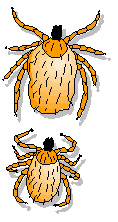Who we are. What we do.
Dr. Schick GmbH, Sinsheim has been working in the field of the development of medical products and food supplements for more than ten years.
In this context we have principally devoted ourselves to the subject of "Removal of firmly attached ticks". As long ago as 1989 pharmacist Dr. G. Schick introduced into pharmacies Tick Tweezers, using which firmly attached ticks can simply be twisted out of the skin. In 1993 the firm of Dr. Schick GmbH was founded and the patent on a new instrument for removing ticks was applied for in 1995.
These patented Ultra Tick Tweezer enable easy removal of both small ticks and fully attached ticks. Dr. Schick’s Tick Tweezers have since been sold in their millions and have proved their worth with a simple mode of operation.
All about ticks.
Ticks are mites (Acarii) with leather-like expandable skin and belong to the Arachnida class. They are the largest  species of mites and usually at the same time exoparasites (they do not penetrate the inside of the host). Birds, reptilies and mammals (rodents, bats, cloven-hoofed animals) and mammals (vertebrates living on land, including humans) all act as hosts.
species of mites and usually at the same time exoparasites (they do not penetrate the inside of the host). Birds, reptilies and mammals (rodents, bats, cloven-hoofed animals) and mammals (vertebrates living on land, including humans) all act as hosts.
They are divided into 3 families:
- Soft-bodied ticks (Argasidae)
- Hard-backed ticks (Ixodidae)
- Nuttalliellidae (Nuttalliella namaqua Bedford) – only known species.
Dissemination
Soft-bodied ticks are confined to the Tropics and Sub-tropics, but hard-backed ticks are found all over the world. Their occurrence depends very much on their hosts, as they have up to 7 nymph stages with change of host.
Habitats
Ticks live mainly in scrubland, in tall grasses and ferns or in undergrowth. They are usually brushed from plants in passing by their potential hosts, which they recognise from vibrations, body heat and scents. They then crawl around on the body for several hours, until they have found a suitable place to bite. Ticks are very fussy and prefer slightly damp, warm, thin skin with good blood circulation. The backs of the knees, the hairline, the bend in the groin and the fine hair behind the ears are particularly popular targets. The widespread belief that ticks fall from trees is not normally true. They live close to the ground, so you should avoid tall grass and ferns, possibly also elder bushes, etc. as far as possible.
Features
As ticks are part of the Arachnida family, they too have 8 legs (differing from this, the tick larva has only three pairs of legs). They are the largest representatives of mites and can be up to 4 mm in size (after a blood meal up to 3 centimetres). Hard-backed ticks have hardened chitin armour (scutum) on their rear segment. They have "licking sucking" mouthparts, so they bite into the skin only superficially and then "lick" the issuing blood or lymph. Therefore they do not usually penetrate as far as the capillaries. They secrete a kind of glue which anchors them firmly in the skin and additionally inhibits clotting, the "sting" (hypostome) by which the tick additionally anchors itself being covered in barbs. These are arranged symmetrically, so it is immaterial in which direction the tick is twisted out.
Life cycle
Argasidae have up to 8 identical nymph stages (larvae). Each nymph is dependent on blood from a host, but they change frequently between hosts of different sizes (mouse, cat, human). In Ixodidae (hard-backed ticks, usually found on humans) there is only one nymph stage. After the egg has been laid on grass blades the larva hatches out. It now looks for a suitable interim host (rodent), where it attaches itself by suction and absorbs blood. After sucking it drops off and moults to become the first nymph, which now in turn looks for a larger host (second interim host - cat) and sucks blood there too. Moulting takes place again to produce the second nymph (soft-bodied tick) or the adult animal (hard-backed tick). The fully-grown animal now infests the final host (human, cow). After this last blood meal it drops off and now looks for a female to mate with. The female in turn lays another up to 3000 eggs on blades of grass.
Damaging effect
In particular, reactions to the clotting inhibiter they secrete can lead to paralysis and death, especially if the tick bite was on the back of the head and close to the spinal column (tick paralysis). Tick paralysis is occurring with increasing frequency in the USA, Canada, Australia, but only very rarely in Europe.
Ticks, including in particular hard-backed ticks (Ixodidae), are vectors (carriers) of viruses and bacteria. They can carry, among other things, the infectious diseases Borreliosis and early summer meningoencephalitis ( TBE). The latter is caused by viruses and leads to inflammation of the brain or the meninges. Borreliosis is the disease most frequently carried by ticks in the northern hemisphere. This disease, often accompanied by severe neurophatic symptoms, is caused by bacteria of the spirochaete group.
A Borrelia infection by ticks is possible anywhere in Germany, even in towns. As shown by a study at the Max von Pettenkofer Institute of Hygiene and Microbiology in Munich, "direct contact with bushes in the garden represents a risk which has so far been underestimated" of becoming ill with Lyme borreliosis from tick bites. The number of new infections per year is estimated for Germany at 50,000 to 100,000.
Whereas there has been no way of inoculating against borreliosis to date in Germany, but it can be successfully treated with antibiotics if recognised in time, protective inoculation against TBE is possible. In German-speaking countries the danger of TBE infection exists only in specific areas, though they are extending along the rivers year by year.
Another widespread disease in the northern hemisphere carried by ticks is tularaemia. This Tick bite fever, occurring mainly on the American continent, in the Mediterranean and in Africa, and Boutonneuse fever, as well as various haemorrhagic fevers, such as Omsk haemorrhagic fever, Crimean Congo fever and Kyasanur Forest disease are also carried by ticks. In the Tropics ticks are carriers of spotted, relapsing and Texas fever. Ticks can also carry babesiae, a parasitic species of protozoa.
Prevention
To keep ticks away you should wear long, fastened clothing and sturdy shoes. There are also various insect repellents which may keep ticks away. Therefore you should shake out clothes thoroughly and search them for ticks, shower and examine your body for ticks every time you have been in regions of foliage. Ticks particularly like the areas under the arms or in the pubic region. They need clothing (ticks love soft, snug materials) and body hair to climb. The sooner the ticks are removed the less is the risk of a viral infection.
Removal
Dr. Schick's Ultra Tick Tweezers, available in chemists and guaranteed simple and easy to use, are ideal for removing ticks.
General information: Remove ticks quickly with tweezers. In doing this you should as far as possible grasp the head of the tick with fine tweezers in the direction of the proboscis. Once it has been grasped the grip on the tweezers must not be released. This prevents the saliva and the contents of the tick’s intestines with the pathogens contained in them reaching the bite wound. Other methods (for example removing the tick with adhesives or oil) easily lead to infection, as the tick in this case vomits the virus into the host. According to recent findings the tick should be gently shaken or twisted, as if it is simply pulled out the barbs of the proboscis become really firmly interlocked. The direction of rotation does not matter. After successful removal of the tick the affected site on the skin should be disinfected with alcohol. If it is discovered that remnants have remained in the skin, a doctor should be called to remove them. To kill the tick, it can be put into a vessel containing high-percentage alcohol. This is also suitable for conservation, in case closer determination of the species is required later.
(Source: This is an article from the free Encyclopaedia Wikipedia. The article comes under the GNU Free Documentation License)



